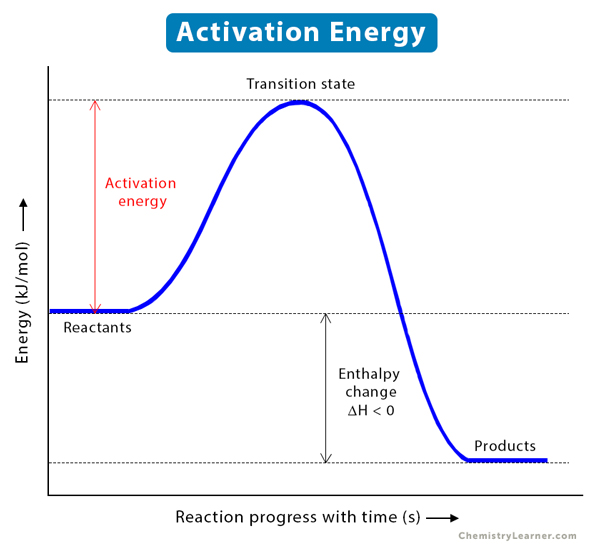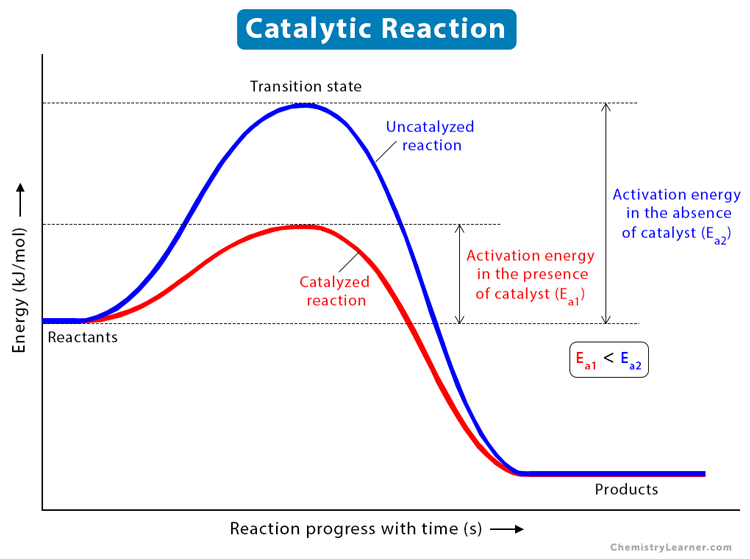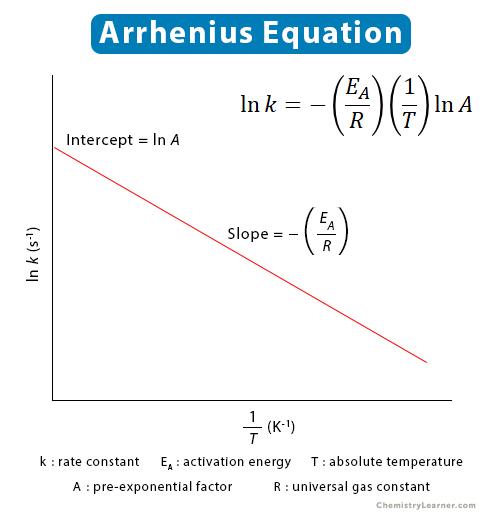Activation Energy
In chemistry, activation energy is the minimum amount of energy required for a chemical reaction. The activation energy can be thought of as the magnitude of a potential barrier that the reacting molecules need to overcome to initiate a reaction and convert into products. Therefore, energy must be supplied to the reactants to increase the kinetic energy of the molecules so that it becomes equal to or greater than this potential barrier [1-4].
How Does Activation Energy Work
To understand how activation energy works, one needs to understand what happens during a chemical reaction. The reactants transform into products. Old bonds break, and new bonds form. Before the bonds break, the molecules deform or bend and get to a high-energy unstable Energy must be supplied to the molecules to reach this state. This energy is the activation energy, and the transient state is known as the transition state. The molecules in the transition state form an activated complex. However, the molecules do not spend much time there due to instability. They come down to a lower-energy state and proceed to the next step of the reaction or form stable products. This concept is illustrated in the energy vs. reaction progress graph below [1-4].
The transition state’s energy is higher than either the reactants or products. Hence, the activation energy is always positive, irrespective of whether the reaction proceeds forward or backward. The activation energy is the energy difference between the transition state and the reactants for a forward reaction. For a reverse reaction, it is the energy difference between the transition state and the products. The difference between the products’ energy and reactants’ energy gives the enthalpy change (ΔH) or heat of reaction. Also, energy must be supplied for a chemical reaction to occur. It holds for exergonic reaction, where energy is eventually released, resulting in negative enthalpy change.
The primary source of activation energy is thermal energy. Thermal energy in the form of heat is supplied to the molecules, increasing their momentum and kinetic energy. As the temperature increases, the molecules move faster and collide frequently. If the temperature increases further, collisions will increase, and more molecules will overcome the activation energy. Once the molecules absorb enough heat to reach the transition state, they can proceed with the remainder of the reaction. It is for this reason that activation energy is important.
Let us look at a few examples to understand activation energy better.
- Water is made from two molecules of hydrogen and one molecule of oxygen. Therefore, the activation energy of the formation of water is the energy required to break the bonds in these molecules.
- A glucose molecule is made up of carbon, hydrogen, and oxygen. When glucose reaches the transition state, bonds between the carbon atoms break down to form carbon dioxide and water.
Activation Energy and Reaction Rate
The activation energy of a chemical reaction is closely connected to its reaction rate. The higher the activation energy, the slower the reaction will be. For example, the rusting of iron is a long process because the activation energy for this reaction is high [1-4].
According to the kinetic theory of matter, molecules have a wide range of kinetic energy. Only a few molecules have enough energy to overcome the activation energy barrier. The higher the activation energy, the smaller the fraction of molecules that can overcome this barrier. Since fewer molecules have reached this level, the reaction will progress slowly. For this reason, many reactions do not proceed at all at room temperature.
Let us look at a few real-life examples to understand reaction rates better. The combustion of propane does not occur unless ignited by fire. Wood does not burn unless lighted by a match. These combustion reactions do not occur spontaneously. In both these cases, the temperature is raised above the room temperature. Thus, having high activation energies for these reactions is favorable. Generally, high temperature and low activation energy result in a large reaction rate.
Catalyst and Enzymes
There is a way to increase the rate of a chemical reaction by using a catalyst. A catalyst is a chemical substance that speeds up chemical reactions by lowering the activation energy. It provides an alternative mechanism (pathway) with lower activation energy without any change. Such a type of reaction is called catalytic reaction or catalysis.
Enzymes are biological catalysts made out of proteins found in the human body. They work by lowering the activation energy and speeding up chemical reactions in the body. They bind the reactant molecules and orient them in a specific manner to initiate the reactions.
How to Find Activation Energy
The Arrhenius equation gives a quantitative expression for the relationship between the activation energy and the rate constant of a reaction. It is a simple and accurate formula used to study the temperature dependence of the rate constant. The common form of the Arrhenius equation is given by an exponential formula [1-5].
k = A exp(-EA/RT)
Where
k : rate constant
A : pre-exponential factor
EA : activation energy
T : temperature
R : universal gas constant ( = 8.314 J M-1 K-1)
Symbol and Unit
The symbol EA represents the activation energy, and its unit is Joule per mole (J/mol) or kiloJoules per mole (kJ/mol).
Arrhenius Plot
An alternative way to write Arrhenius equation is to take the logarithm on both sides.
ln (k) = ln (A) – EA/RT
Rearranging the equation gives
ln (k) = (– EA/R) (1/T) + ln (A)
The above equation is that of a straight line with ln (k) as the dependent variable and 1/T as the independent variable. A plot of the above equation gives the slope equal to – EA/R. From this slope, one can determine the activation energy.
FAQs
Ans. No, activation energy is independent of temperature. To reduce the activation energy, one must use a catalyst.
Ans. For a chemical reaction, the negative activation energy means the reaction rate decreases with the increase in the temperature. Negative activation energy is possible for some elementary reactions. In these reactions, attractive forces exist between the reactants such that there are no barriers or the barriers are submerged.
Ans. Free energy is the energy available for a thermodynamic system to perform work. On the other hand, activation energy is the energy barrier that a chemical reaction has to overcome to proceed and obtain products.
Ans. If an activation energy barrier did not exist, chemical reactions would proceed spontaneously.
Ans. Activation Energy is the additional energy that reactant molecules require to cross the energy barrier and convert into products. The energy required to break the bonds is called bond energy. The two are not always the same.







